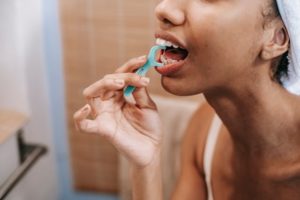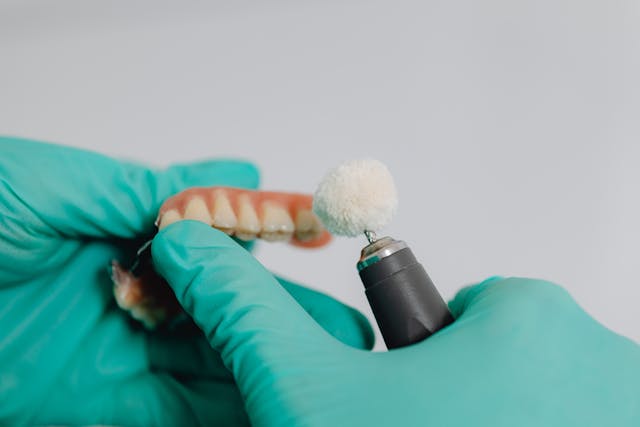Maintaining good oral hygiene is essential for a healthy smile, and daily flossing plays a crucial role in keeping your teeth and gums free from plaque.
With a wide range of dental flossing tools available, choosing the right one for your oral care routine can feel overwhelming. So, which option is best for you? This blog explores different types of flossing tools and provides guidance on selecting the ideal choice to meet your needs.
Why is It Important to Floss?
Flossing reaches areas around the teeth and along the gum line that a toothbrush misses. It reduces plaque buildup and prevents diseases like gingivitis and periodontitis. In fact, research shows that people who regularly floss have a decreased risk of heart disease.

The American Dental Association advises flossing once daily and brushing twice a day to clean your teeth and maintain oral health.
Flossing as an adjunct to brushing can create wonders for your oral health. Understanding which flossing tools work best for your situation may help you determine the difference between cleaning your teeth and achieving optimal oral health.
Types of Flossing Tools Available
It is essential to select the right flossing tools for your teeth. Some of the most widely used tools for flossing are as follows:
Traditional Dental Floss

This is the most commonly used type of dental floss device. Traditional floss is either waxed or unwaxed and is made of nylon or PTFE (polytetrafluoroethylene). The U.S. Food and Drug Administration classifies dental floss as a Class I device, indicating it is considered low-risk in its use.
- Best for general patients with healthy gums and regular spacing of the teeth.
- Pros: Very affordable and accessible.
- Cons: It can be difficult to use for individuals with orthodontic work, such as braces, or for those with closely spaced teeth.
Floss Picks

Floss picks are small plastic flossing tools holding a piece of dental floss. The other end is modified to form a toothpick. They’re excellent for quick flossing on the go.
- Best for busy people and those with limited dexterity.
- Pros: Convenient, easy to use, perfect for kids.
- Cons: The length of floss can be limited, which may reduce the effectiveness of cleaning compared to regular floss.
Water Flossers (Oral Irrigators)
Water flossers utilize a pressurized water stream that removes plaque and food particles from between the teeth and under the gums.
- Best for individuals with braces, dental implants, or those with periodontal disease.
- Pros: Gentle on the gums, highly effective at cleaning hard-to-reach spaces
- Cons: Expensive, needs electrical power as well as access to water.

Interdental Brushes
Interdental brushes are flossing tools that look like tiny bottle brushes and clean between the teeth. They’re especially great for people with larger gaps in their teeth or who have dental work.
- Best for people with gaps, braces, or a bridge.
- Pros: Can be used many times; cleaner than floss when used to clean bigger spaces.
- Cons: Not suitable for people with very tight spaces between the teeth.
Floss Threaders
Floss Threaders are flexible, thin teeth flossing tools that help you thread the floss through tight spaces under your braces and bridges.
- Best flossing tools for those with braces, bridges, or permanent retainers.
- Pros: It helps floss hard-to-access areas.
- Cons: It is more challenging to use than standard floss.
How to Choose the Best Flossing Tools?
You can consider the following key factors while choosing the best dental floss tool:

- While some flossing devices might be more accessible for others, others are inherently easier to manipulate. Traditional floss will prove challenging for someone with limited dexterity. However, floss picks and water flossers are much easier to handle.
- For people who travel much or need to floss outside of their residence, you might be interested in the portability features of floss picks. They are convenient to take with you, compact to keep in a pocket or purse, and fast to clean between meals without any effort.
- Cost is an important factor to consider when selecting flossing tools. Traditional dental floss is the most affordable option, but water flossers, while more expensive, can be beneficial for patients with certain dental needs.
- Sensitive gums may need a water flosser or even soft, waxed floss for maximum advantage. A water flosser would be gentle and not irritating to sensitive gums, whereas waxed floss is smoother than plain floss, gliding effortlessly in between tight teeth for minimal discomfort.
However, the best flossing tool is subjective and depends on personal preference, dental health needs, and ease of use. You should consult your dentist before deciding on the best flossing tool. In fact, many dental care providers recommend combining different flossing tools to achieve maximum efficiency.
Conclusion
Flossing is essential to maintaining a healthy smile. Whether it’s good old-fashioned traditional dental floss, a water flosser, or interdental brushes, consistency toward optimal oral health is the bottom line.
Remember to floss daily and consult your dentist to determine which flossing tools are best for your teeth and gums. You can keep your teeth and gums healthy and avoid the problems associated with broken or damaged dental work.
Proper flossing tool selection will boost your oral hygiene routine and support long-term oral health. Here’s to happy flossing!
RiverRock Dental can cater to all your dental treatment needs. Contact our dental office today or schedule a consultation for a smile assessment or guidance on oral hygiene. We’re here to help you achieve a healthy, pain-free smile!
Our address: 403 1st Ave East Shakopee, MN 55379
Phone : (952) 445-5556






